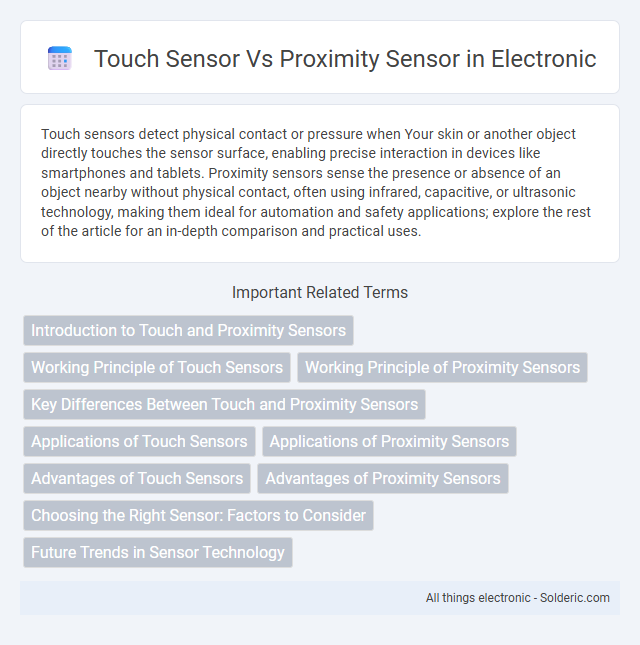Touch sensors detect physical contact or pressure when Your skin or another object directly touches the sensor surface, enabling precise interaction in devices like smartphones and tablets. Proximity sensors sense the presence or absence of an object nearby without physical contact, often using infrared, capacitive, or ultrasonic technology, making them ideal for automation and safety applications; explore the rest of the article for an in-depth comparison and practical uses.
Comparison Table
| Feature | Touch Sensor | Proximity Sensor |
|---|---|---|
| Function | Detects physical contact or touch | Detects presence of objects without contact |
| Detection Method | Capacitive, resistive, or mechanical | Infrared, ultrasonic, or electromagnetic |
| Typical Range | Direct contact only | Few centimeters to several meters |
| Applications | Touchscreens, buttons, user interface | Object detection, automation, safety |
| Response Time | Instant on touch | Instant on object presence |
| Power Consumption | Low power | Variable; can be higher depending on sensor type |
| Environmental Sensitivity | May malfunction with moisture or dirt | Can be affected by ambient light or interference |
Introduction to Touch and Proximity Sensors
Touch sensors detect physical contact or pressure applied on a surface, using technologies like capacitive or resistive sensing to register direct user interaction. Proximity sensors identify the presence or absence of objects nearby without physical contact, utilizing infrared, ultrasonic, or electromagnetic fields for detecting movement or distance. Both sensors are integral in consumer electronics, automotive systems, and industrial automation for enhancing user interface and safety functions.
Working Principle of Touch Sensors
Touch sensors operate by detecting physical contact through changes in electrical properties such as capacitance, resistance, or pressure applied on the sensor surface. Capacitive touch sensors sense the change in the electrostatic field caused by a conductive object like a human finger, while resistive touch sensors detect pressure that completes an electrical circuit. These sensors convert physical touch into electrical signals that trigger corresponding responses in electronic devices.
Working Principle of Proximity Sensors
Proximity sensors operate by detecting the presence of nearby objects without physical contact, using methods like capacitive, inductive, ultrasonic, or infrared sensing. They emit electromagnetic fields or waves and measure the changes caused by an object's presence, such as shifts in capacitance or reflected signals. This non-contact detection contrasts with touch sensors that require direct physical interaction to register input.
Key Differences Between Touch and Proximity Sensors
Touch sensors detect physical contact through pressure or capacitance changes, while proximity sensors sense the presence of an object without direct contact using electromagnetic fields or ultrasonic waves. Touch sensors require direct interaction from Your body or an object, making them ideal for buttons and switches, whereas proximity sensors trigger responses by detecting nearby items, often used in automation and security systems. The key difference lies in their interaction type: touch sensors need physical touch, and proximity sensors enable non-contact detection, enhancing versatility in various applications.
Applications of Touch Sensors
Touch sensors are widely used in smartphones, tablets, and interactive kiosks to enable intuitive user interfaces through direct contact detection. They play a critical role in wearable devices and home automation systems by providing precise input control and enhancing user experience. Industrial machinery and medical equipment also utilize touch sensors for reliable, hygienic operation and efficient control.
Applications of Proximity Sensors
Proximity sensors are widely used in industrial automation for object detection, ensuring safety and efficiency on assembly lines by detecting the presence or absence of components. They play a critical role in smartphones and tablets for functions like turning off the screen during calls to prevent accidental touches. Your security systems benefit from proximity sensors through motion detection, enabling automated lighting and intrusion alerts without physical contact.
Advantages of Touch Sensors
Touch sensors offer precise, tactile feedback that enhances user interaction by detecting direct physical contact. They are highly responsive and consume less power compared to proximity sensors, making them ideal for handheld and wearable devices. Your device benefits from increased accuracy and user-friendly interface when integrating touch sensor technology.
Advantages of Proximity Sensors
Proximity sensors offer non-contact detection, which reduces wear and tear and enhances durability compared to touch sensors that require physical contact. They provide faster response times and can detect objects or movements through various materials, making them ideal for harsh or hygienic environments. Your applications benefit from increased reliability and reduced maintenance costs with proximity sensor technology.
Choosing the Right Sensor: Factors to Consider
Choosing the right sensor depends on your specific application requirements, including detection range, environmental conditions, and response time. Touch sensors excel in direct physical interaction scenarios, offering precise activation through contact, while proximity sensors detect objects without contact, ideal for non-intrusive presence sensing over variable distances. Consider factors such as material compatibility, power consumption, and durability to ensure optimal performance and seamless integration into your system.
Future Trends in Sensor Technology
Touch sensors and proximity sensors are increasingly integrated with AI and IoT for smarter, context-aware applications. Emerging materials like graphene enhance sensitivity and durability, while energy-efficient designs enable longer device lifespans. Your future devices will benefit from seamless, adaptive interactions powered by these advanced sensor technologies.
touch sensor vs proximity sensor Infographic

 solderic.com
solderic.com